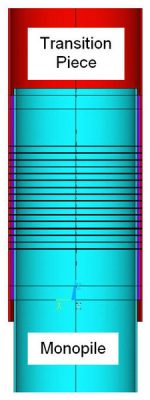
Transition Piece
Transition Piece
The transition piece acts as a transition piece between a driven pile (monopile) and the tower of an offshore wind turbine. The installation process involves the transition piece being slipped over the monopile with a certain overlap length. The annular gap between the two pipes is then filled or grouted with a grouting mortar.
The grouted annular gap has two main functions:
- the transfer of the charges related to the permanent and variable actions,
- and for compensation of imperfections due to the driving procedure.
In the formation of the transition piece, two variants have prevailed:
- Cylindrical steel pipes with thrust ribs and
- Conical steel pipes without shear ribs.




Until 2007, cylindrical grouted connections without shear ribs were used. However, their load-bearing and fatigue strength proved to be insufficient under dynamic loads. Slippage occurred between the transition piece and the monopile, which is known as the shake-down effect. As a result, intensive research work was carried out and new regulations were introduced in the offshore guidelines.
Current designs with transition pieces are planned either as cylindrical steel tubes with shear ribs or as conical steel tubes without shear ribs. Thanks to the use of large rolling mills and thick plates, transition pieces with a diameter of more than 7,000 mm can now be produced. These are then used for the so-called XL monopiles.
Grout-Verbindungen
Grout connections are frequently used in maritime technology, particularly on oil platforms, overseas bridges and offshore wind power towers. These are overlap joints between two steel pipes of different diameters. The cement-bonded high-performance grouting material is poured into the annular space between two steel pipes.
The grout joint transmits internal forces through shear and friction between the pipe wall and the grout body. The prediction methods for the axial load-bearing capacity of grout connections with shear bolts and their application areas in current codes were analysed in a recent study. The study shows that the prediction of the axial strength of grouted joints varies depending on the method used. The UK Health and Safety Executive (HSE, 2002) calculation formula has obvious limitations. In particular, the strength is overestimated in the case of increasing shear connectors, which leads to uncertain design results.
The results obtained by Det Norske Veritas (DNV, 2013) generally agree with the experimental results, where the reduction effect of several shear bars was taken into account. The prediction method of the American Petroleum Institute (API, 2007) is overly conservative and underestimates the load-bearing capacity of connections. In contrast, the method of combined Det Norske Veritas-Germanischer Lloyd (DNV-GL, 2016) safe, reliable and economical and has a wider range of applications.
Our services
Seitens der SKI engineering company the following services can be provided:
- Load simulations in the ultimate limit state
- Calculations of fatigue loads in the time and frequency domain
- Evidence for welded connections and bolted connections
- Calculation of ring flange connections
- Berücksichtigung von Wellenlasten bei Offshore-Türmen
- Design of grouted Joints and pile-sleeve connections
- Local stress and fatigue calculations for grout and steel

Copyright © 2025
SKI Ingenieurges. mbH
Mengendamm 12
30177 Hannover
Phone: +49 (0) 511 / 261847-0

